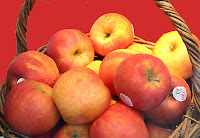Apples: Good for the Body
Hello, Everyone!
Today, we are learning a bit more about the apple and how it benefits the body, including the hair of
the scalp, when eaten.
 |
| Apples - Image courtesy, Wikipedia |
- The apple is the pomaceous fruit of the apple tree, species Malus domestica in the rose family (Rosaceae). It is one of the most widely cultivated fruit trees, and the most widely known of the many members of genus Malus that are used by
humans. - The tree originated in Western Asia, where its wild ancestor, the Alma, is still found today. There are more than 7,500 known cultivars of apples, resulting in a range of desired characteristics. Cultivars vary in their yield and the ultimate size of the tree, even when grown on the same rootstock.
- Apples are often eaten raw without consuming the seeds, which are slightly poisonous (see below), the whole fruit including the skin is suitable for human consumption. Varieties bred for this purpose are termed dessert or table apples.
- Apples can be canned or juiced. They are milled to produce apple cider (non-alcoholic, sweet cider) and filtered for apple juice. The juice can be fermented to make cider (
alcoholic, hard cider), ciderkin, and vinegar. Through distillation, various alcoholic beverages can be produced, such as applejack, Calvados, and apfelwein. Pectin and apple seed oil may also be produced. - Sliced apples turn brown due to the conversion of natural phenolic substances into melanin, upon exposure to oxygen. Different cultivars vary in their propensity to brown after slicing. Sliced fruit can be treated with acidulated water to prevent this effect if it isn't going to be eaten immediately after slicing.
Organic apples are the better choice, as compared to non-organic apples, since non-organic apples have a significantly high level of pesticide residue on them.- Eating fallen apples, rather than eating apples picked directly from the tree, may put the eater at the risk of food poisoning if the apple orchard is also the area for keeping cattle or other animals. This is true due to the fact that fallen apples may become contaminated with animals' fec
es. Furthermore, the risk may be significantly higher if the fallen apples are used to make home-made unpasteurized, unfermented cider or juice
, thus letting E. coli multiply. - A ripe, raw apple digests in eighty-five minutes.
- The cultivated apple tree is at its prime when it is, approximately, fifty years old
- The cultivated apple tree will bear fruit for more than one hundred years





